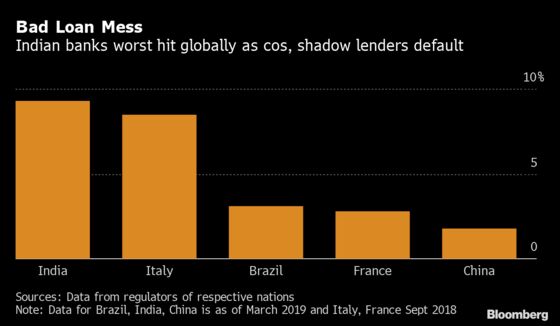A Corner of Indian Banking Sends New Shudder Through Markets
Among that plethora of lenders, only the 54 biggest are monitored by the central bank.

(Bloomberg) -- Indian regulators’ ability to come to grips with the nation’s banking crisis has been thrown into doubt amid reports that a cooperative lender had extended outsize loans to an insolvent developer.
The Reserve Bank of India last week took the rare step of limiting withdrawals from Mumbai-based Punjab & Maharashtra Co-operative Bank Ltd. On Sunday, local media reported that loans to Housing Development & Infrastructure Ltd., a developer currently in bankruptcy court, accounted for almost three-quarters of unlisted PMC’s outstanding lending.
That figure was much higher than one provided by a former top executive at PMC and sowed confusion about the cooperative banking sector, where some 97,000 lenders oversee a combined $130 billion of deposits according to CLSA Ltd. -- nearly a tenth of the wider industry’s total.
Among that plethora of lenders, only the 54 biggest are monitored by the central bank and investors are now trying to figure out whether they pose a new threat to a banking system hobbled by a 9.3% bad-loan ratio, the highest in the world.

“Such instances only reiterate that there is a need for tighter supervision for urban cooperative banks,” said Saswata Guha, director of financial institutions at Fitch Ratings Ltd. in Mumbai. “I really hope this is an isolated case.”
Shares of HDIL, as the debt-ridden developer that benefited from PMC’s largess is called, tumbled to a record low at the close of trading on Monday. The companies couldn’t immediately be reached. The RBI had no comment.
Indian banks are required to limit exposure to single borrowers to less than a fifth of the total.
The drumbeat of bad news in India’s banking market shows few signs of letting up. Mortgage lender Indiabulls Housing Finance Ltd. tumbled a record 34% on Monday after a series of setbacks, including a petition to probe the lender over allegations that it gave out questionable loans.
Indiabulls Housing’s woes also appeared to drag down Yes Bank Ltd., which is trying to raise new capital after bad loans eroded its buffers. Yes Bank issued a statement Monday saying its exposure to a “housing finance/real estate conglomerate” -- which it didn’t name -- “is totally secured.” The bank’s stock closed 15% lower.
‘Eye Opener’
Junior Finance Minister Anurag Thakur on Monday called the PMC incident an “eye opener” and that some media reports about the lender “are very shocking.” He didn’t name HDIL.
K Joy Thomas, the former managing director of PMC, told the RBI that HDIL accounted for 73% of the bank’s total loan book, Press Trust of India reported on Sunday, citing an unidentified source. In an interview with BloombergQuint, Thomas had indicated a far lower estimate.
Thomas didn’t return calls seeking comment.
What Bloomberg Opinion Says
How did PMC’s board, its auditors and the central bank remain clueless for so long? So far nobody has been charged; the entire burden has been placed at the door of depositors, who are innocent victims.
--Andy Mukherjee, columnist
Click here to read the piece
India’s cooperative banks, set up to serve areas where banking services aren’t widely available to all people, typically cater to poorer, less credit-worthy customers.
The RBI monitors only the cooperative banks, including PMC, that are considered systemically important. Of those, about half faced credit and liquidity risks in stress tests conducted by the RBI, according to its latest financial stability report.
That presents a headache for RBI Governor Shaktikanta Das, who is trying to draw a line under bank implosions after a major infrastructure lender defaulted last year. Das has said the central bank won’t allow another systemically important shadow lender to fail.
“The second round of impact of the crisis accentuated by these lightly regulated lenders will depend on the future course of action by policy makers,” said Karthik Srinivasan, group head of financial sector ratings at ICRA Ltd., the local unit of Moody’s Investors Service.
Limits Loosened
The RBI didn’t name any specific borrower when it placed restrictions on PMC deposits last week, but it cited major financial irregularities, a failure of internal controls, and inaccurate reporting that understated exposures.
It has since loosened some of the withdrawal limits, which has served to ease -- although not completely remove -- fears among depositors. The central bank also removed PMC’s management.
Loans from PMC helped HDIL stave off insolvency proceedings for a time, Thomas told BloombergQuint on Friday. Other lenders, led by Bank of India, dragged the real estate developer into the bankruptcy process in August. The court has appointed a resolution professional.
To contact the reporters on this story: Suvashree Ghosh in Mumbai at sghosh186@bloomberg.net;Dhwani Pandya in Mumbai at dpandya11@bloomberg.net
To contact the editors responsible for this story: Marcus Wright at mwright115@bloomberg.net, Philip Lagerkranser
©2019 Bloomberg L.P.